Abstract
The ability to isolate rhinoviruses in human heteroploid cell cultures was investigated by inoculating HeLa cells (HeLa M) with specimens previously shown to be positive in human diploid cell cultures. The 135 positive specimens selected were representative of 22 different rhinovirus types, and 4 to 9 specimens were available for each serotype. Specimens were inoculated into human diploid fetal tonsil fibroblasts (FT), HeLa cells with 30 mM Mg2+, and HeLa cells without increased Mg2+. One hundred twelve rhinovirus strains (83%) were reisolated in FT cells, whereas 76 rhinovirus strains (56%) were recovered in HeLa cells with 30 mM Mg2+. All strains recovered in FT were the same serotype as that originally recovered in diploid cells, but five of the HeLa cell isolates (3.7% of total specimens) were different serotypes, indicating dual rhinovirus infections. Four rhinovirus serotypes, (3, 42, 48, and 70) were recovered in HeLa but not in diploid cells; these serotypes were rare in our previous studies. Isolation of rhinovirus in FT cells was usually accomplished at first passage, whereas rhinovirus cytopathic effects in HeLa cells were not observed at first passage, but required one, two, or (rarely) three blind passages. Only 28 rhinoviruses (21%) were recovered in HeLa cells without increased Mg2+; however, three serotypes, types 16, 36, and 58, were recovered as effectively in HeLa cells, with or without added Mg2+, as they were in FT cells. In general, rhinoviruses were less efficiently recovered in HeLa cells; however, certain serotypes may be detected better by HeLa cells.
Full text
PDF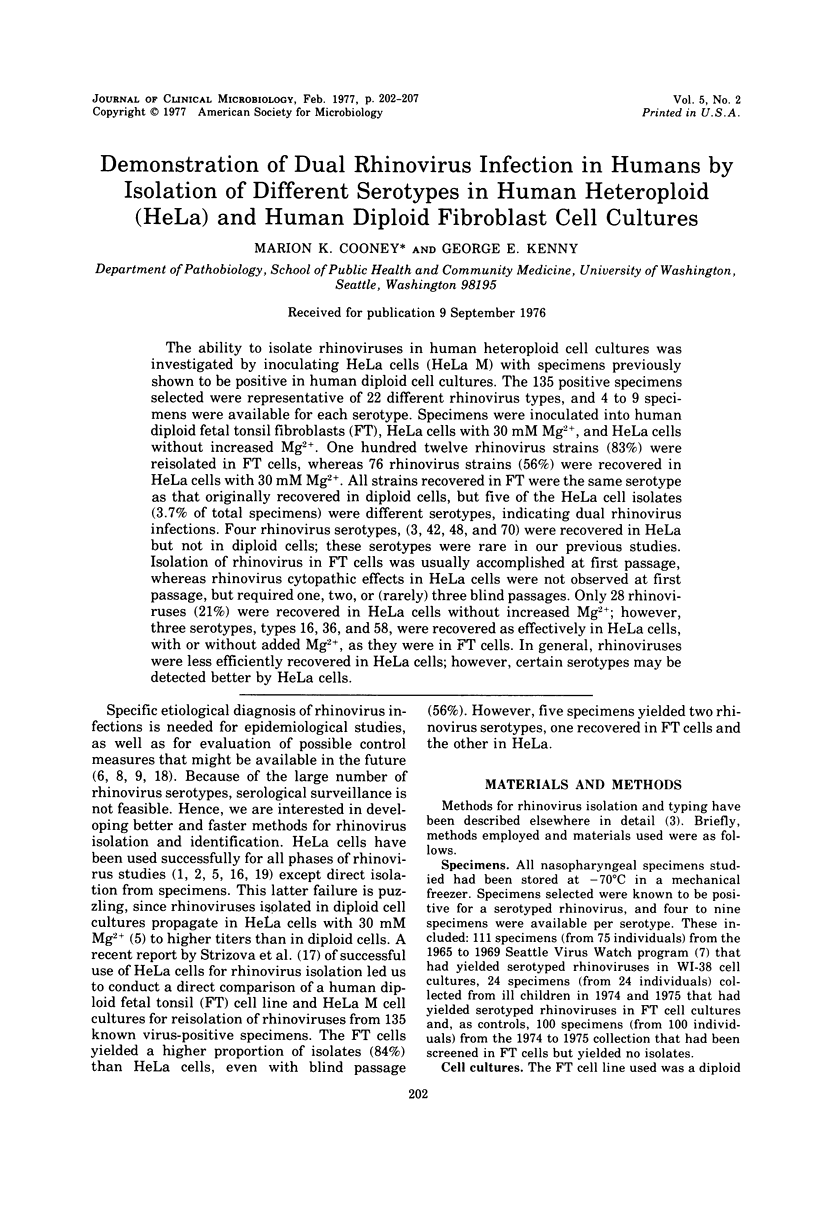
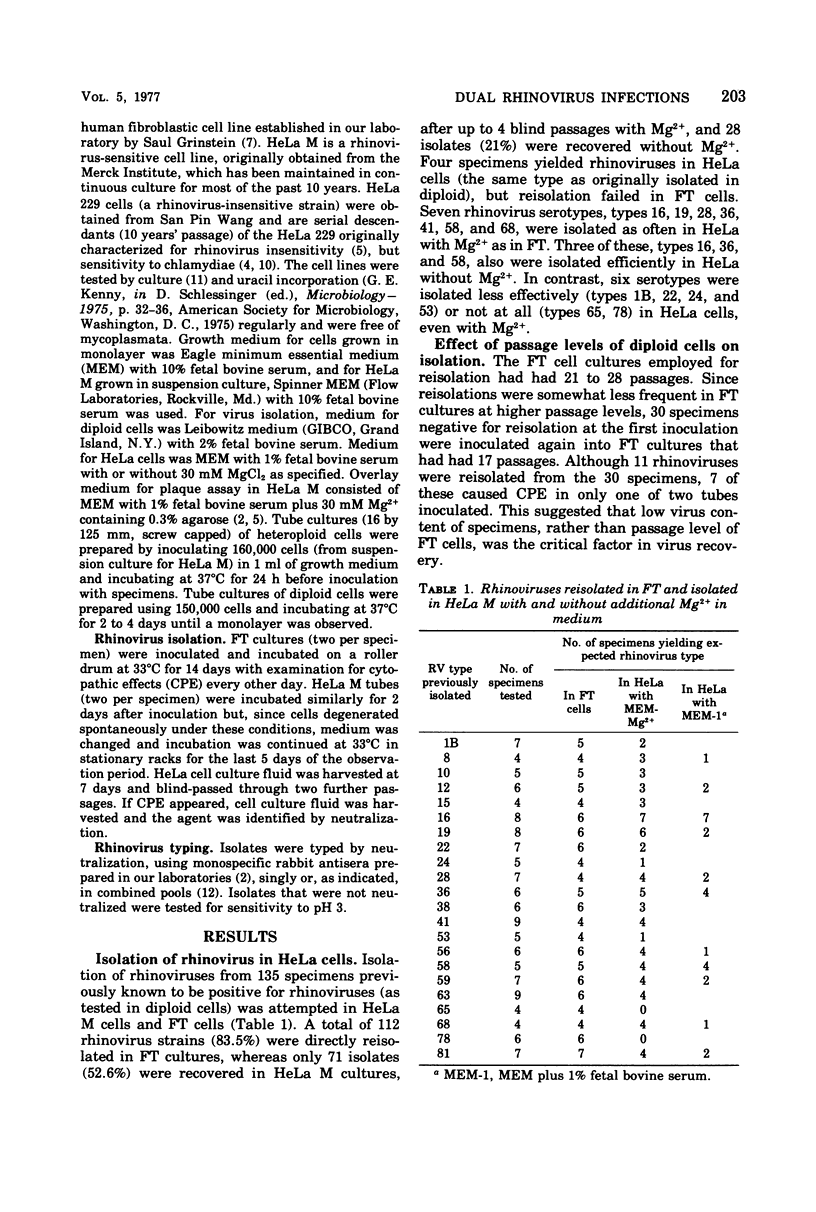
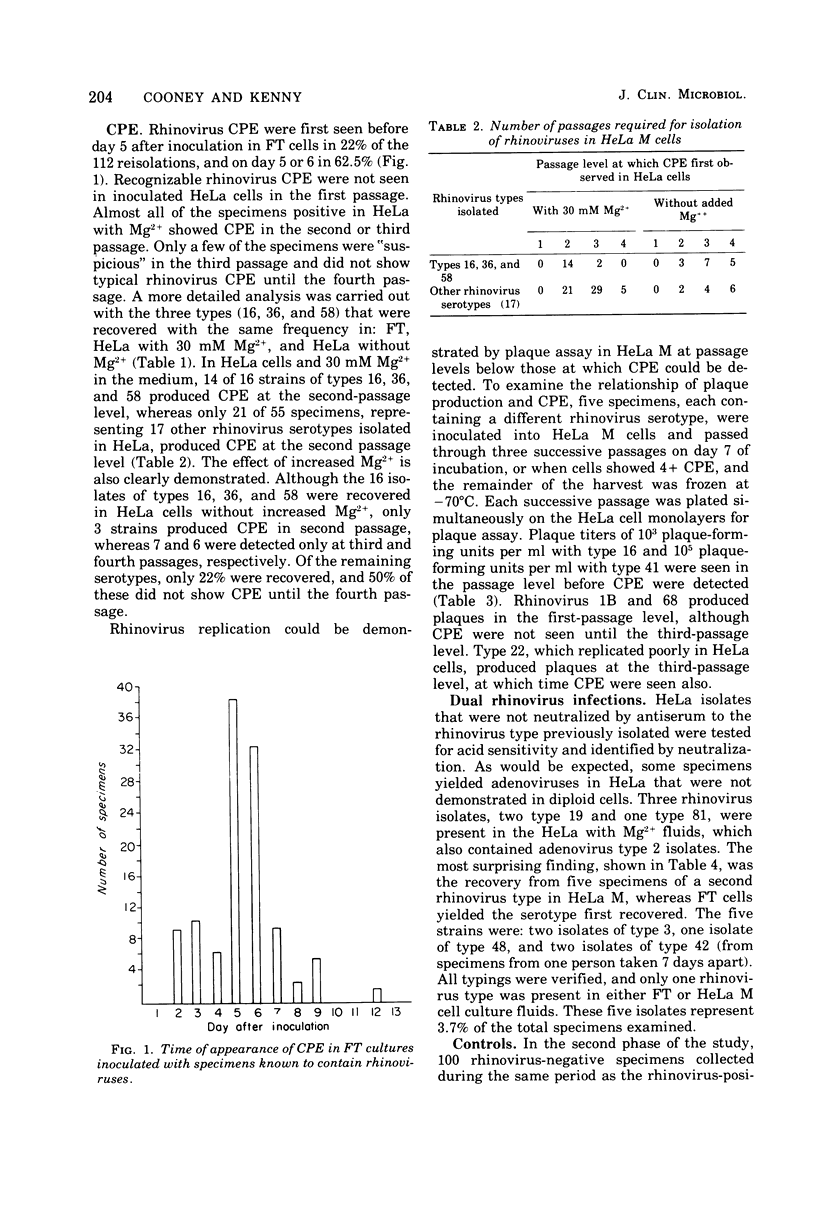
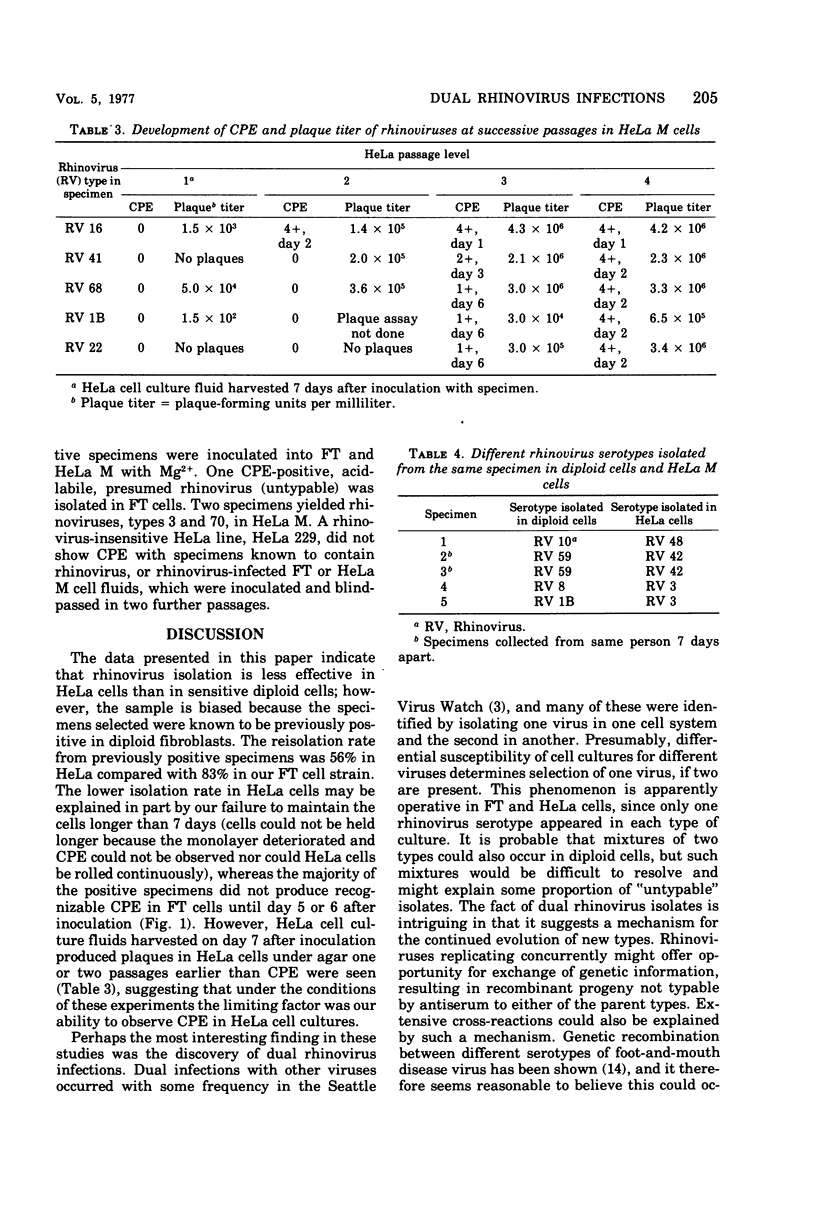
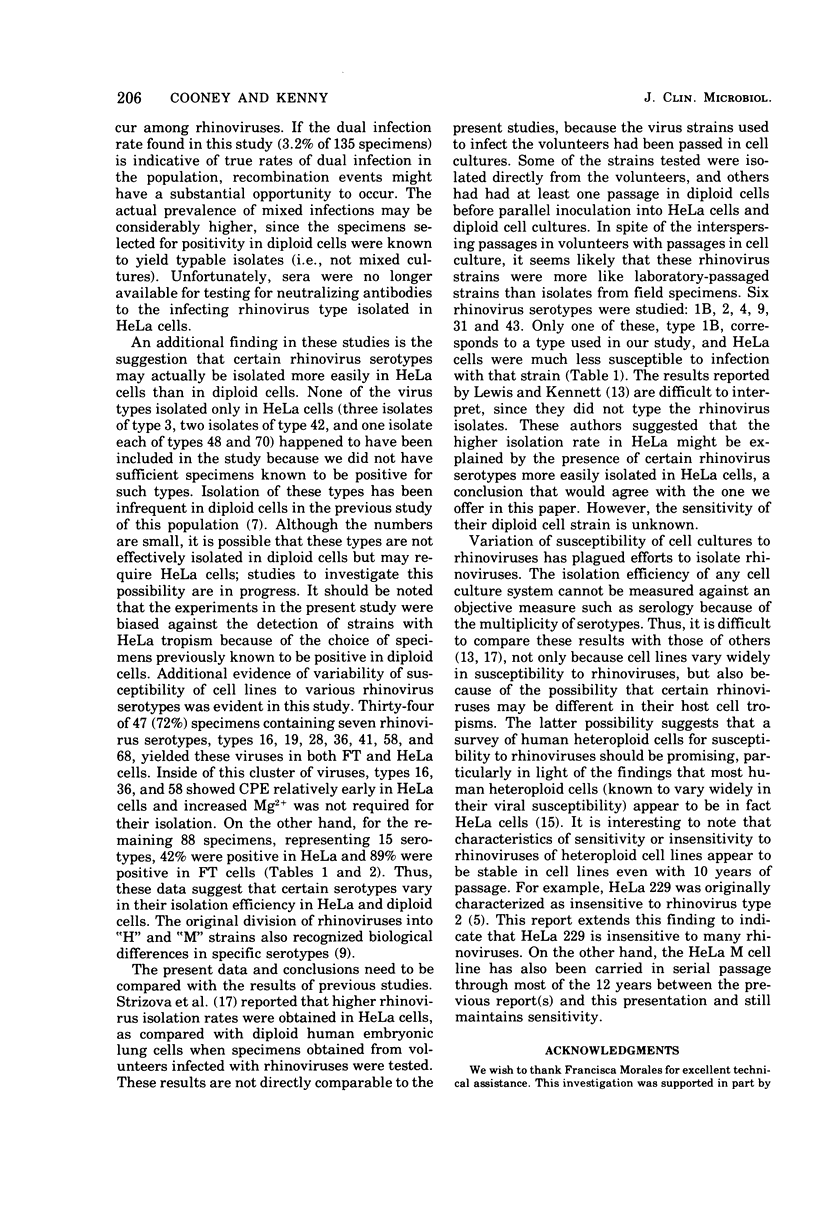
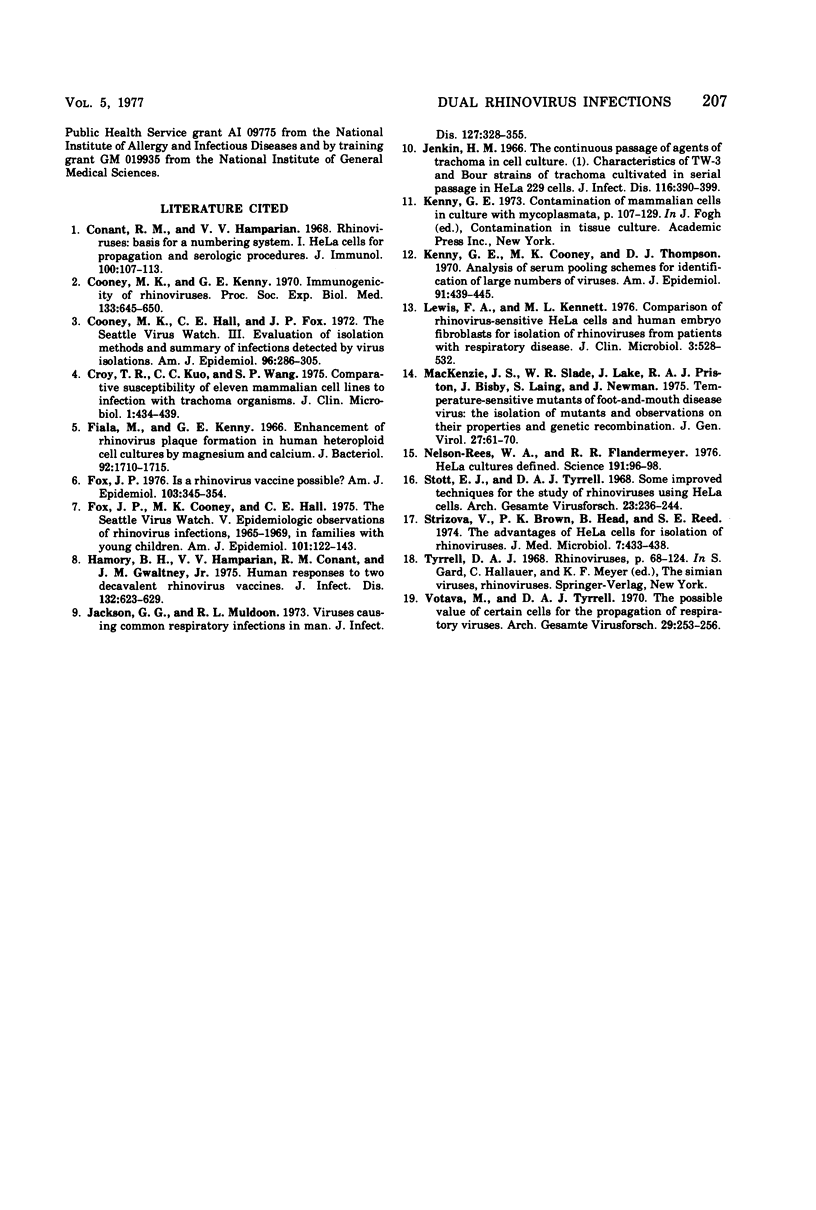
Selected References
These references are in PubMed. This may not be the complete list of references from this article.
- Conant R. M., Hamparian V. V. Rhinoviruses: basis for a numbering system. 1. HeLa cells for propagationand serologic procedures. J Immunol. 1968 Jan;100(1):107–113. [PubMed] [Google Scholar]
- Cooney M. K., Hall C. E., Fox J. P. The Seattle virus watch. 3. Evaluation of isolation methods and summary of infections detected by virus isolations. Am J Epidemiol. 1972 Oct;96(4):286–305. doi: 10.1093/oxfordjournals.aje.a121459. [DOI] [PubMed] [Google Scholar]
- Cooney M. K., Kenny G. E. Immunogenicity of rhinoviruses. Proc Soc Exp Biol Med. 1970 Feb;133(2):645–650. doi: 10.3181/00379727-133-34536. [DOI] [PubMed] [Google Scholar]
- Croy T. R., Kuo C. C., Wang S. P. Comparative susceptibility of eleven mammalian cell lines to infection with trachoma organisms. J Clin Microbiol. 1975 May;1(5):434–439. doi: 10.1128/jcm.1.5.434-439.1975. [DOI] [PMC free article] [PubMed] [Google Scholar]
- Fiala M., Kenny G. E. Enhancement of rhinovirus plaque formation in human heteroploid cell cultures by magnesium and calcium. J Bacteriol. 1966 Dec;92(6):1710–1715. doi: 10.1128/jb.92.6.1710-1715.1966. [DOI] [PMC free article] [PubMed] [Google Scholar]
- Fox J. P., Cooney M. K., Hall C. E. The Seattle virus watch. V. Epidemiologic observations of rhinovirus infections, 1965-1969, in families with young children. Am J Epidemiol. 1975 Feb;101(2):122–143. doi: 10.1093/oxfordjournals.aje.a112078. [DOI] [PubMed] [Google Scholar]
- Fox J. P. Is a rhinovirus vaccine possible? Am J Epidemiol. 1976 Apr;103(4):345–354. doi: 10.1093/oxfordjournals.aje.a112233. [DOI] [PubMed] [Google Scholar]
- Hamory B. H., Hamparian V. V., Conant R. M., Gwaltney J. M., Jr Human responses to two decavalent rhinovirus vaccines. J Infect Dis. 1975 Dec;132(6):623–629. doi: 10.1093/infdis/132.6.623. [DOI] [PubMed] [Google Scholar]
- Jenkin H. M. The continuous passage of agents of trachoma in cell culture. I. Characteristics of TW-3 and Bour strains of trachoma cultivated in serial passage in HeLa 229 cells. J Infect Dis. 1966 Jun;116(3):390–399. doi: 10.1093/infdis/116.3.390. [DOI] [PubMed] [Google Scholar]
- Kenny G. E., Cooney M. K., Thompson D. J. Analysis of serum pooling schemes for identification of large numbers of viruses. Am J Epidemiol. 1970 Apr;91(4):439–445. doi: 10.1093/oxfordjournals.aje.a121154. [DOI] [PubMed] [Google Scholar]
- Lewis F. A., Kennett M. L. Comparison of rhinovirus-sensitive HeLa cells and human embryo fibroblasts for isolation of rhinoviruses from patients with respiratory disease. J Clin Microbiol. 1976 May;3(5):528–532. doi: 10.1128/jcm.3.5.528-532.1976. [DOI] [PMC free article] [PubMed] [Google Scholar]
- MacKenzie J. S., Slade W. R., Lake J., Priston R. A., Bisby J., Laing S., Newman J. Temperature-sensitive mutants of foot-and-mouth disease virus: the isolation of mutants and observations on their properties and genetic recombination. J Gen Virol. 1975 Apr;27(1):61–70. doi: 10.1099/0022-1317-27-1-61. [DOI] [PubMed] [Google Scholar]
- Nelson-Rees W. A., Flandermeyer R. R. HeLa cultures defined. Science. 1976 Jan 9;191(4222):96–98. doi: 10.1126/science.1246601. [DOI] [PubMed] [Google Scholar]
- Stott E. J., Tyrrell D. A. Some improved techniques for the study of rhinoviruses using HeLa cells. Arch Gesamte Virusforsch. 1968;23(3):236–244. doi: 10.1007/BF01241896. [DOI] [PubMed] [Google Scholar]
- Strizova V., Brown P. K., Head B., Reed S. E. The advantages of HeLa cells for isolation of rhinoviruses. J Med Microbiol. 1974 Nov;7(4):433–438. doi: 10.1099/00222615-7-4-433. [DOI] [PubMed] [Google Scholar]
- Votava M., Tyrrell D. A. The possible value of certain cells for the propagation of respiratory viruses. Arch Gesamte Virusforsch. 1970;29(2):253–256. doi: 10.1007/BF01249310. [DOI] [PMC free article] [PubMed] [Google Scholar]


